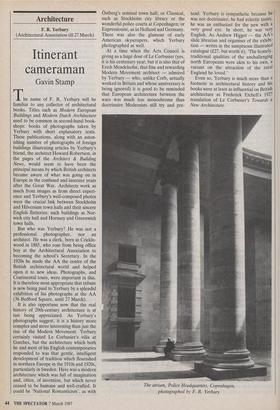Architecture
F. R. Yerbury (Architectural Association till 27 March)
Itinerant cameraman
Gavin Stamp
The name of F. R. Yerbury will be familiar to any collector of architectural books. Titles such as Modern European Buildings and Modern Dutch Architecture used to be common in second-hand book- shops: books of photographs taken by Yerbury with short explanatory texts. These publications, along with an aston- ishing number of photographs of foreign buildings illustrating articles by Yerbury's friend, the architect Howard Robertson, in the pages of the Architect & Building News, would seem to have been the principal means by which British architects became aware of what was going on in Europe in the confused and insecure years after the Great War. Architects work as much from images as from direct experi- ence and Yerbury's well-composed photos were the crucial link between Stockholm and Hilversum town halls and their sincere English flatteries: such buildings as Nor- wich city hall and Hornsey and Greenwich town halls.
But who was Yerbury? He was not a professional photographer, nor an architect. He was a clerk, born in Crickle- wood in 1885, who rose from being office boy at the Architectural Association to becoming the school's Secretary. In the 1920s he made the AA the centre of the British architectural world and helped open it to new ideas. Photographs, and Continental tours, were important in this. It is therefore most appropriate that tribute is now being paid to Yerbury by a splendid exhibition of his photographs at the AA (36 Bedford Square, until 27 March).
It is also opportune now that the real history of 20th-century architecture is at last being appreciated. As Yerbury's photographs suggest, it is a history more complex and more interesting than just the rise of the Modern Movement. Yerbury certainly visited Le Corbusier's villa at Garches, but the architecture which both he and most of his English contemporaries responded to was that gentle, intelligent development of tradition which flourished in northern Europe in the 1910s and 1920s, particularly in Sweden. Here was a modern architecture which was full of imagination and, often, of invention, but which never ceased to be humane and well-crafted. It could be 'National Romanticism', as with Cistberg's seminal town hall; or Classical, such as Stockholm city library or the wonderful police courts at Copenhagen; or Expressionist, as in Holland and Germany. There was also the glamour of early American skyscrapers, which Yerbury photographed as well.
At a time when the Arts Council is giving us a huge dose of Le Corbusier (yes, it is his centenary year; but it is also that of Erich Mendelsohn, that fine and rewarding Modern Movement architect — admired by Yerbury — who, unlike Corb, actually worked in Britain and whose anniversary is being ignored) it is good to be reminded that European architecture between the wars was much less monochrome than doctrinaire Modernists still try and pre- tend. Yerbury is sympathetic because he was not doctrinaire; he had eclectic tastes, he was an enthusiast for the new with a very good eye. In short, he was very English. As Andrew Higgot — the AA's slide librarian and organiser of the exhibi tion — writes in the sumptuous illustrated catalogue (£27, but worth it), 'The homely, traditional qualities of the unchallenging north Europeans were akin to his own, a variant on the attraction of the rural England he loved.'
Even so, Yerbury is much more than a footnote in architectural history and his books were at least as influential on British architecture as Frederick Etchell's 1927 translation of Le Corbusier's Towards a New Architecture.
The atrium, Police Headquarters, Copenhagen, photographed by F. R. Yerbury


























































 Previous page
Previous page